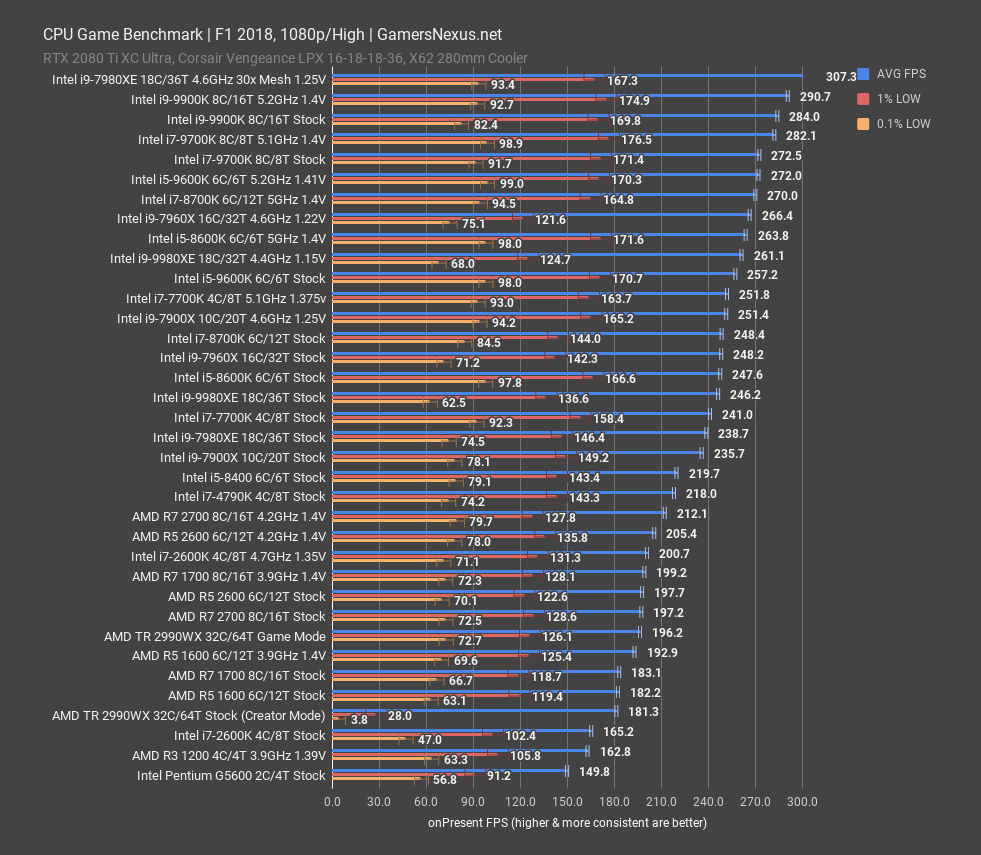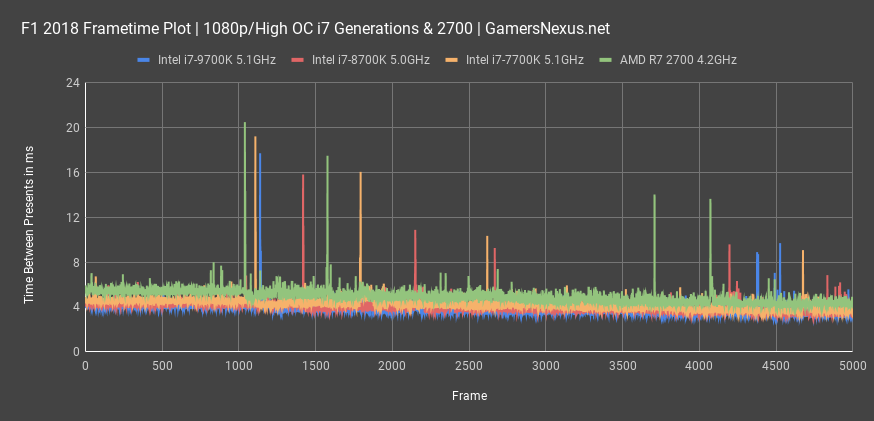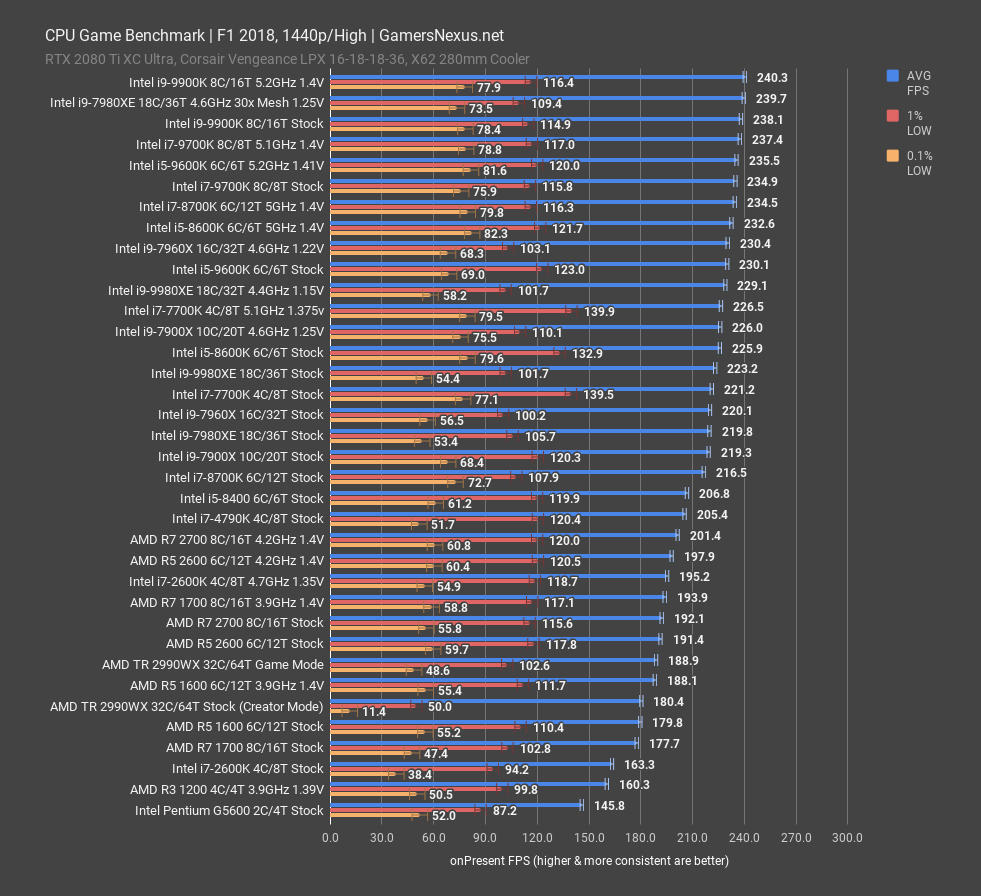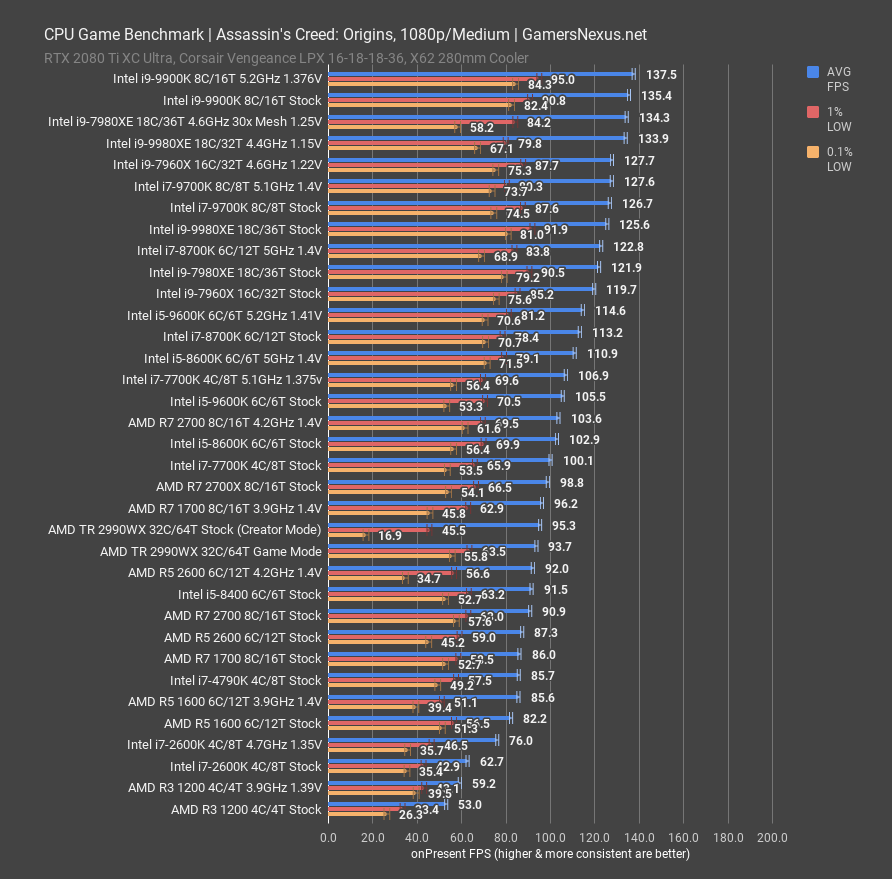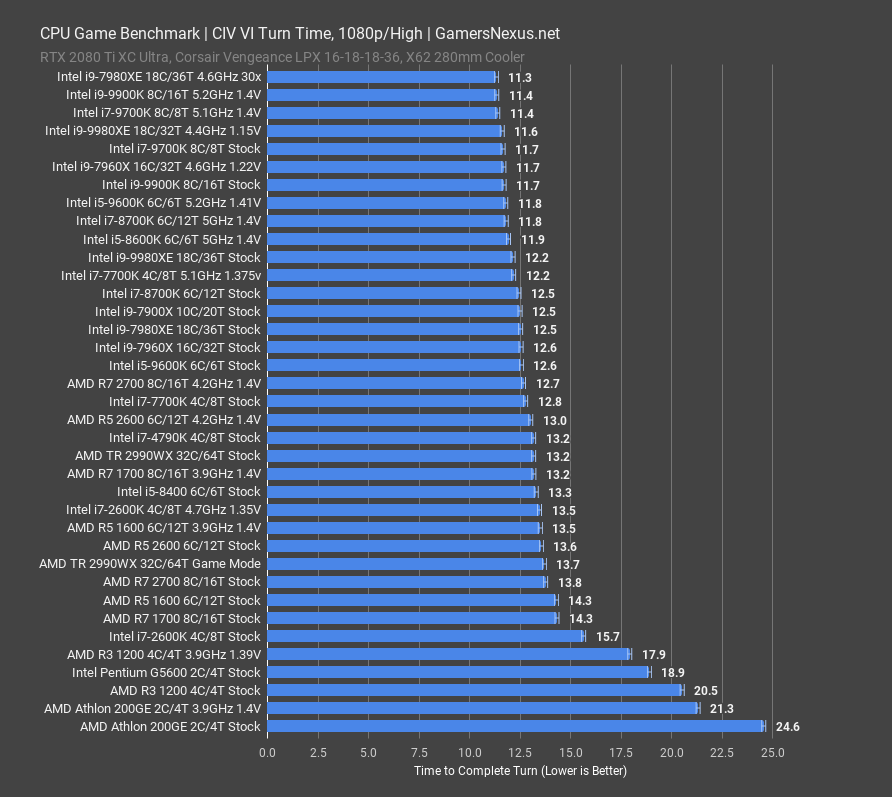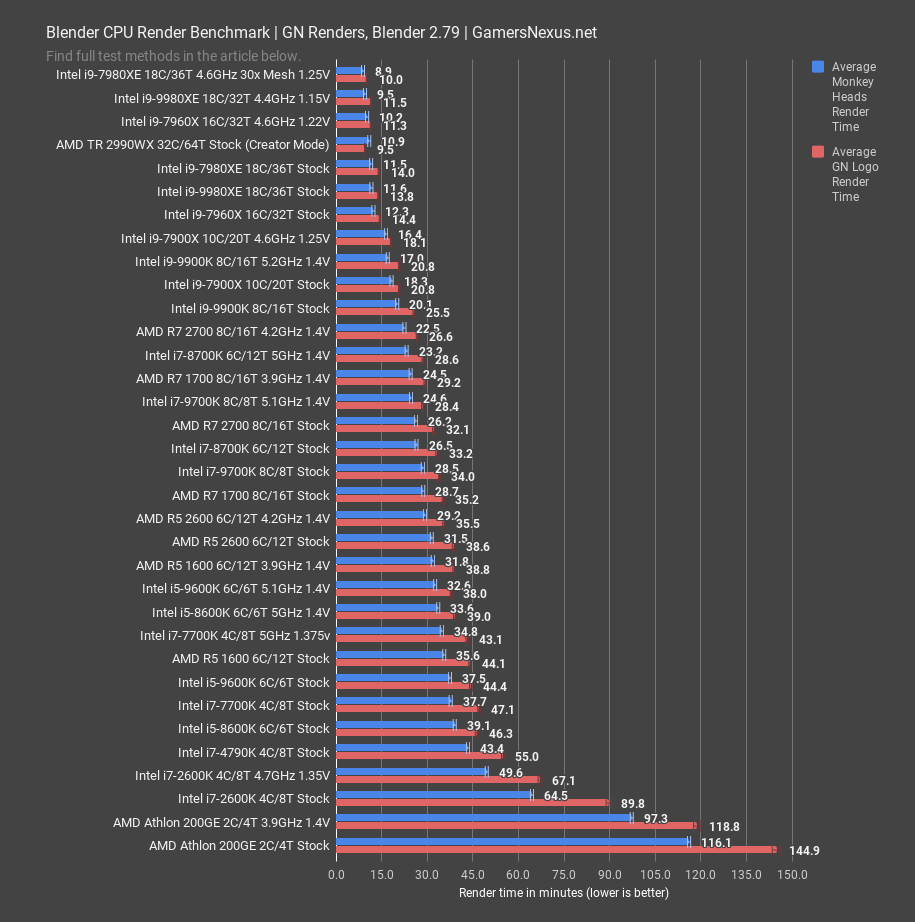We’re revisiting the Intel i7-7700K today, following its not-so-distant launch of January of 2017 for about $340 USD. The 7700K was shortly followed by the i7-8700K, still selling well, which later in the same year but with an additional two cores and four threads. That was a big gain, and one which stacked atop the 7700K’s already relatively high overclocking potential and regular 4.9 to 5GHz OCs. This revisit looks at how the 7700K compares to modern Coffee Lake 8000 and 9000 CPUs (like the 9700K), alongside modern Ryzen CPUs from the Zen+ generation.
For a quick reminder of 7700K specs versus “modern” CPUs – or, at least, as much more “modern” as a 1-year-later launch is – remember that the 7700K was the last of the 4C/8T parts in the i7 line, still using hyper-threading to hit 8T. The 8700K was the next launch in the family, releasing at 6C/12T and changing the lineup substantially at a similar price-point, albeit slightly higher. The 9900K was the next remarkable launch but exited the price category and became more of a low-end HEDT CPU. The 9700K is the truer follow-up to the 7700K, but oddly regresses to an 8T configuration from the 8700K’s 12T configuration, except it instead uses 8 physical cores for all 8 threads, rather than 6 physical cores. Separately, the 7700K critically operated with 8MB of total cache, as opposed to 12MB on the 9700K. The price also changed, with the 7700K closer to $340 and the 9700K at $400 to $430, depending. Even taking the $400 mark, that’s more than adjustment for inflation.
We’re revisiting the 7700K today, looking at whether buyers truly got the short straw with the subsequent and uncharacteristically rapid release of the 8700K. Note also, however, that the 8700K didn’t really properly release at end of 2017. That was more of a paper launch, with few products actually available at launch. Regardless, the feeling is the same for the 7700K buyer.
Test Components
Tested CPUs primarily include the below list:
- Intel i9-9900K
- AMD R7 2700
- AMD R7 2700X
- Intel i7-8700K
- AMD R5 2600
- AMD R5 2600 OC (2600X stand-in)
- Intel i5-8600K
- Intel i9-7900X
- Intel i9-7960X
- AMD R7 1700
- Intel i7-4790K
Motherboards used for testing are as follows:
- ASUS Maximus XI Hero Z390
- Gigabyte Gaming 9 Z370
- Gigabyte Z97X Gaming G1 BK
- ASUS Crosshair VII Hero X470
- ASUS Crosshair VI Hero X370
- Gigabyte X299 Gaming 9
- MSI GD65 Z77 w/ HyperX Savage DDR3 32GB 2166MHz (max supported)
Constants used are as follows:
- All desktop platforms: 2x 8GB 3200MHz Corsair Vengeance LPX 16-18-18-36 DDR4
- (Exception: Z97X uses HyperX Savage 2133MHz DDR3)
- All quad-channel HEDT platforms: 4x 8GB 3200MHz Corsair Vengeance LPX 16-18-18-36 DDR4
- Corsair AX1600i PSU
- NZXT Kraken X62 at 100% speeds
Windows 10 version 1803 was used for all testing with Windows Update disabled. PresentMon is used for framerate data logging, with custom scripts for capturing data accurately.
Intel i7-7700K vs. 9700K, 9900K – F1 2018 Benchmark
F1 2018 uses the EGO engine by Codemasters, placing the 7700K stock CPU at 241FPS AVG – still a fully capable performer in this type of game. It is bottlenecking our RTX 2080 Ti, but performance is still high enough to support most other high-end GPUs without stifling them too much. A 1080 Ti would be a good fit. This is highly dependent upon title, so that may change with other games. The stock 7700K is flanked primarily by the preceding Devil’s Canyon 4790K at 218FPS AVG and by the succeeding i7-8700K at 248FPS AVG. For the 8700K and 7700K, differences are negligible. It would be difficult to notice a 0.1ms difference in frametime, if not impossible. For Ryzen comparisons, the closest would be the 2700 (similar to a 2700X) at 4.2GHz, ranking 212FPS AVG and nearing the 4790K in performance.
A frametime comparison would be apt here as well, enabling us to better look at the performance of frame consistency or, as some people like to call it, “smoothness.” The Y-axis is frame-to-frame interval, or frametime measured in milliseconds, and the X-axis is the frame count. We want a consistent line with as few deviations from the mean as possible, and when there is a deviation, we want it to be fewer than an 8-12ms change frame-to-frame as that tends to be about the human perceptual range for frametime consistency.
This plot gets busy fast, but staggering the line reveal (in the video) helps a bit. The 7700K ends up right around where the 8700K is when both are overclocked to 5.1 and 5.0GHz, respectively. The result is a roughly equivalent frame-to-frame interval, with also roughly equivalent frametime spikes when they occur. The spikes never exceed 20ms for the 7700K so, while a few are noticeable in play, there aren’t enough to really mar the experience meaningfully. Every CPU, AMD and Intel, seems to encounter these spikes, making it more likely a function of the game.
At 1440p, scaling remains the same and the 7700K is firmly planted between the 8700K stock CPU and 8600K stock CPU. Overclocking the 7700K puts it just below the 9600K stock CPU, showing limitations of the Kaby Lake architecture and 4C/8T approach.
Assassin’s Creed: Origins Benchmark – Intel i7-7700K Revisit in 2019
Assassin’s Creed: Origins gives us a look at a Ubisoft title, something that Far Cry 5 will also enable when we get to it next. With ACO at 1080p/Medium, the 7700K stock CPU benchmarks at 100FPS AVG, which places it just below the 8600K stock CPU’s 103FPS AVG. Frametime consistency between the two is functionally the same and scales about as you’d expect. The overclocked 1700 at 3.9GHz is also not too distant from the 7700K, although 0.1% lows begin to dip a bit. As for the 4790K, just for perspective, that’s at 86FPS AVG and around performance of a stock 170, with the Intel i5-2600K at 63FPS AVG when stock. Overclocking the 7700K puts it at 107FPS AVG, or around the performance of a 5GHz 8600K. Generationally, the 8700K offers meaningful uplift to 113FPS AVG when stock, as compared to 100FPS AVG on the stock 7700K, while the 9700K pushes the bar to 127FPS AVG stock, and the 9900K to 135FPS AVG stock.
Intel i7-7700K Benchmark - Far Cry 5
Far Cry 5 is next and gives us another Ubisoft title with a different underlying engine. At 1080p/Normal, this one places the 7700K stock CPU at 115FPS AVG, or right above the R5 2600 when set to 4.2GHz. The 7700K at 5.1GHz lands it between the 8600K stock CPU and 8400 stock CPU, so not that exciting overall for the old 7700K, but still not bad for hanging on.
At 1440p, the stack is similar: The 7700K at 5.1GHz is right around where the 7960X sits, ahead of the 4.2GHz R5 2600, and behind the stock 8700K by a somewhat meaningful amount.
Intel i7-7700K Civilization VI Turn Time Benchmark
As we always note, Civilization VI and other grand campaign games are all about turn completion time, or the time required for AI players to figure out their next moves. With multiple AI players in the game, it can take minutes to get back to your next play if on a slow processor.
The i7-7700K ends up at 12.8 seconds stock, placing it around the same place as the R7 2700 at 4.2GHz and just behind the 7960X at stock speeds. These two flanking CPUs help illustrate that this game prefers frequency to threads, though it can still make use of both (as illustrated by the 7980XE at the top), it’s just a matter of having enough frequency. With a relatively big overclock to 5.1GHz, at least for the 7700K, the CPU ends up at 12.2 seconds for a turn time reduction of 5% over the stock 7700K. The overclocked result puts it around the 8700K stock CPU, at 12.5 seconds, and not distant from the 8600K at 5GHz, which benefits from a few additional physical cores and some architectural advancements.
The 9700K performs significantly faster than the stock 7700K, at 11.7 seconds for its turn time completion and posting a reduction of 8.6%. For perspective of the product stack shift this generation, the 9900K ends up at 11.4 seconds when at 5.2GHz, a noteworthy reduction over the 7700K. As for how much you notice these changes, that’ll depend on how many AI players are present and how complex the turns get.
Blender Production Benchmark – R7 2700 OC vs. 7700K
Blender is last, giving us a look at production capabilities of the 7700K as compared to modern CPUs. This is where the 7700K starts to lose its relative staying power in other applications, like games, because tile-based renderers like Blender will leverage one thread per tile being drawn. The 7700K stock CPU takes 38 minutes to render the GN Monkey Heads, or 47 minutes to render the GN Logo intro animation. Overclocking the 7700K to 5.0GHz – because 5.1GHz was unstable and crashing – plants it firmly at the performance level of the R5 1600, or close enough to it to be a fair comparison. The 8600K at 5GHz holds a lead over the 7700K, despite the 2-thread deficit, and the 9700K provides significant time reduction from 38 minutes on the 7700K stock to 29 minutes on the 9700K. A time reduction of 25% is noticeable in rendering workloads, but Ryzen still does better here at the same price category. For an example, we can highlight the 2700 stock CPU and its 26-minute monkey head render time, or the overclocked variant at 4.2GHz with a 23-minute completion time. If you’re using Blender or other renderers where a new tile is generated for each thread, this is where AMD’s CPUs come into play. Chances are that a 7700K owner bought their system before Ryzen came out, so we wanted to highlight what AMD has done well with while you’ve been away.
Conclusion: Is the i7-7700K Still Good in 2018? Or 2019, Depending.
It’s basically 2019, but this conclusion may change by end of year. Intel still has its fabled 10nm processors on the roadmap for sometime in 2019, including the Sunny Cove CPUs that we previously discussed in depth. AMD also has its much-discussed Ryzen 2nd Generation due for 2019, marking two highly anticipated CPU launches.
All of this is relevant, because the i7-7700K is still a fully capable performer. Unless it’s holding you back professionally – e.g., you’re using your computer to make money, and you’re making less because it’s not as fast as some other product – it’s really not worth upgrading. In the instance where you’re restrained professionally, it’s worth considering an upgrade – it’ll just depend on the budget and potential for ROI increase, which is something you must judge.
For gaming or lightweight production tasks, like occasional gameplay edits, the 7700K is still fully acceptable. The R7 2700(X) and the i7-9700K both feel like lateral upgrades, or “sidegrades,” with measurable gains in different departments that aren’t wholly game-changing. We think that it makes sense to hang onto the 7700K for another generation, or at least until Ryzen 3000 series CPUs and Intel Sunny Cove CPUs see more news published. We don’t typically advise waiting an indeterminate period of time, but it’s easy with the 7700K. Despite its purchasers getting a bit burned by the 9-month rush to launching the ensuing 8700K, both coming out in 2017, the 7700K is still a perfectly adequate performer in the tasks we tested. We’d say wait it out a bit longer and, if you haven’t already, consider overclocking to boost performance in the interim.
Editorial, Host: Steve Burke
Testing: Patrick Lathan
Video: Keegan Gallick, Andrew Coleman
